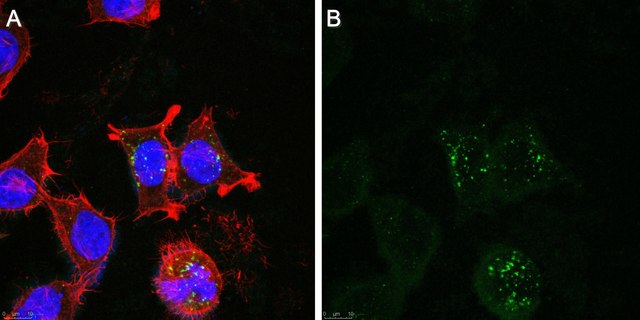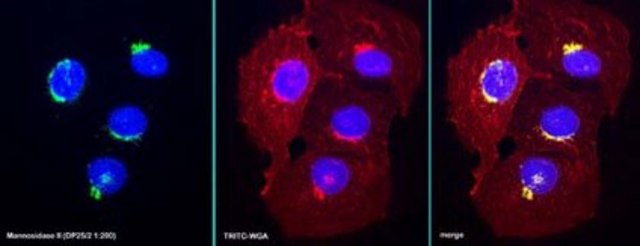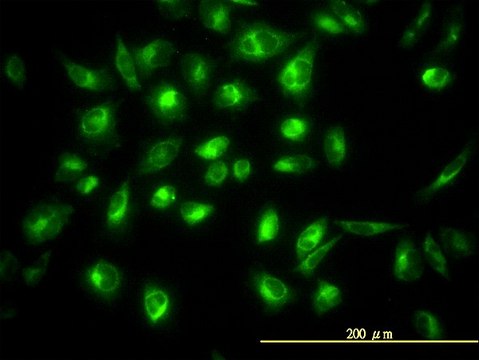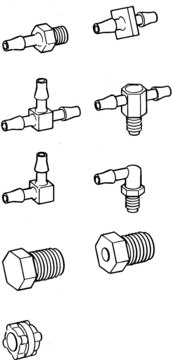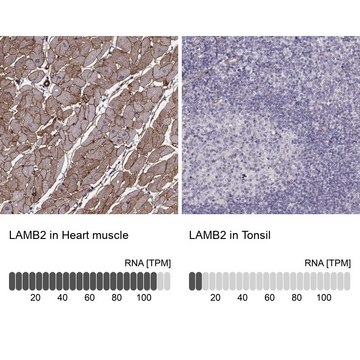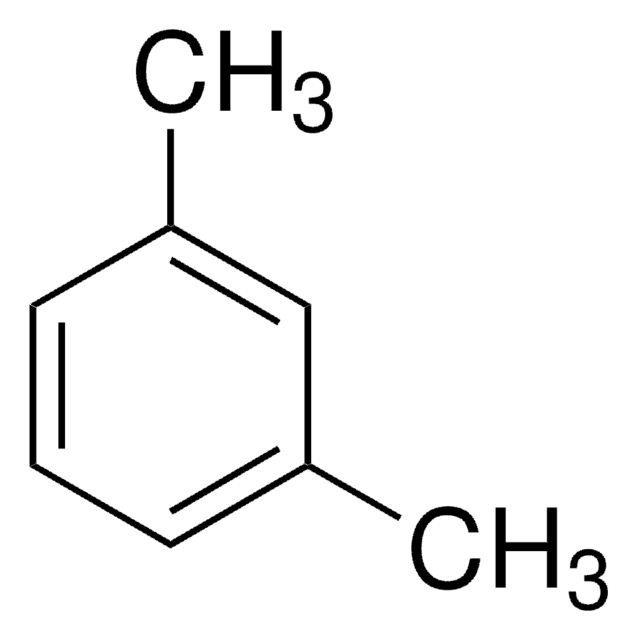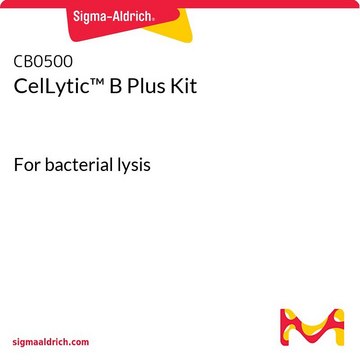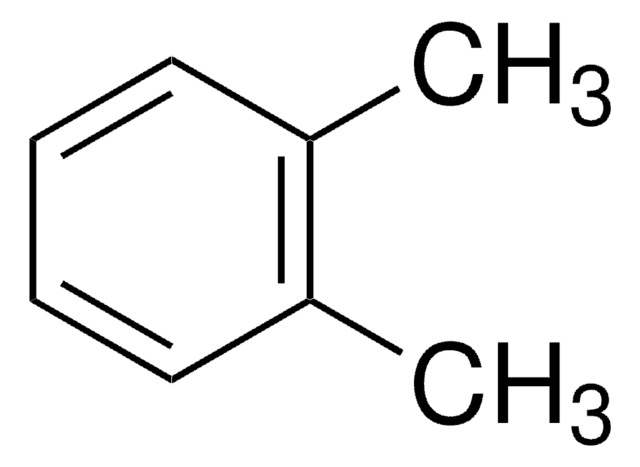推荐产品
生物来源
mouse
抗体形式
culture supernatant
抗体产品类型
primary antibodies
克隆
371-4, monoclonal
种属反应性
human
制造商/商品名称
Chemicon®
技术
immunohistochemistry: suitable
输入
sample type neural stem cell(s)
同位素/亚型
IgG1
运输
dry ice
靶向翻译后修饰
unmodified
一般描述
Part of the cytoplasm occupied by the Golgi apparatus.
特异性
Stains golgi zone area in human cells.
应用
Anti-Golgi Zone Antibody, clone 371-4 is an antibody against Golgi Zone for use in IH.
Indirect immunofluorescence at 1:20-1:30, 30 - 100 μL per slide well.
Optimal working dilutions must be determined by the end user.
Subcellular Particles
Suggested Protocol
IMMUNOFLUORESCENCE AND ANTIBODY AND ANTIBODY SCREENING PROCEDURE:
Hybridoma supernatants are examined by indirect immunofluorescence on cell preparations of human lymphnoid cells. In order to examine many samples in a short period of time, washed cells (wash 2 times in wash buffer at 4°C) at a concentration of 5 x 10 cells/mL in PBS are pipetted dropwise on PTFE-coated printed microscope slides containing ten 5 mM wells/slide. After the cells are allowed to settle to the surface of the glass (10-15 minutes only), the overlying fluid is quickly removed by aspiration and the cells are dried to slide by a gentle stream of warm air. The slides are then immediately fixed in 2% formaldehyde, ultrapure, in PBS for 15 minutes at room temperature. After fixation, the slides are rinsed in PBS and placed in acetone at -20°C for 3 minutes to make the cells permeable. After a final rinse in PBS to remove the acetone, the slides are stored in PBS at 4°C indefinitely in covered Coplan jars.
In addition to the lymphnoid cultures, normal human epithelial cells can be screened by indirect immunofluorescence microscopy for positive reactions with the hybridoma supernatants. Since the human epithelial cells grow as monolayer cultures, they are plated directly onto the printed microscope slides after trypsinization and allowed to attach and grow overnight at 37°C incomplete medium. The following day, the slides are briefly rinsed in PBS to remove the medium and the cells are fixed as described above. In general, the slides are not allowed to air dry either during or after the fixation procedure in order to maintain the cellular integrity and antigenicity of intracellular molecules.
For photographic analysis, viable cell preparations obtained from Ficoll®-hypaque gradient separations are cytocentrifuged directly onto slides at 1,250 rpm for 10 minutes. This procedure flattens the lymphnoid cells and greatly improves the visibility of intranuclear and cytoplasmic antigens. Slides prepared in this manner are fixed in the same way directly after cytocentrifugation.
In order to screen the hybridoma supernatants by indirect immunofluorescence, 30-100 μL of each supernatant (optimize for each individual assay) are pipetted on a well of the printed microscope slides using a different tip for each supernatant. After 60 minutes of incubation at 37°C in a humidified chamber, the slides are rinsed 3 times with PBS at room temperature, and again incubated for 30 minutes at 37°C with 20 μL of a 1:20 dilution of fluorescein-conjugated goat anti-mouse IgG antibody (Millipore AP124F). The slides are then rinsed 3 times with PBS, counterstained with Evans Blue for 5 minutes at room temperature using a freshly prepared solution containing 50 μL of a 1% stock solution of Evans Blue in 80 mL of PBS, rinsed a final time in PBS, and coverslipped using a 1:1 solution of glycerol:PBS. The slides are then examined by epifluorescence microscopy. Since many of the monoclonal antibodies produced a rapidly diminishing fluorescent reaction, exposure times optimally are less than 5 seconds.
Optimal working dilutions must be determined by the end user.
Subcellular Particles
Suggested Protocol
IMMUNOFLUORESCENCE AND ANTIBODY AND ANTIBODY SCREENING PROCEDURE:
Hybridoma supernatants are examined by indirect immunofluorescence on cell preparations of human lymphnoid cells. In order to examine many samples in a short period of time, washed cells (wash 2 times in wash buffer at 4°C) at a concentration of 5 x 10 cells/mL in PBS are pipetted dropwise on PTFE-coated printed microscope slides containing ten 5 mM wells/slide. After the cells are allowed to settle to the surface of the glass (10-15 minutes only), the overlying fluid is quickly removed by aspiration and the cells are dried to slide by a gentle stream of warm air. The slides are then immediately fixed in 2% formaldehyde, ultrapure, in PBS for 15 minutes at room temperature. After fixation, the slides are rinsed in PBS and placed in acetone at -20°C for 3 minutes to make the cells permeable. After a final rinse in PBS to remove the acetone, the slides are stored in PBS at 4°C indefinitely in covered Coplan jars.
In addition to the lymphnoid cultures, normal human epithelial cells can be screened by indirect immunofluorescence microscopy for positive reactions with the hybridoma supernatants. Since the human epithelial cells grow as monolayer cultures, they are plated directly onto the printed microscope slides after trypsinization and allowed to attach and grow overnight at 37°C incomplete medium. The following day, the slides are briefly rinsed in PBS to remove the medium and the cells are fixed as described above. In general, the slides are not allowed to air dry either during or after the fixation procedure in order to maintain the cellular integrity and antigenicity of intracellular molecules.
For photographic analysis, viable cell preparations obtained from Ficoll®-hypaque gradient separations are cytocentrifuged directly onto slides at 1,250 rpm for 10 minutes. This procedure flattens the lymphnoid cells and greatly improves the visibility of intranuclear and cytoplasmic antigens. Slides prepared in this manner are fixed in the same way directly after cytocentrifugation.
In order to screen the hybridoma supernatants by indirect immunofluorescence, 30-100 μL of each supernatant (optimize for each individual assay) are pipetted on a well of the printed microscope slides using a different tip for each supernatant. After 60 minutes of incubation at 37°C in a humidified chamber, the slides are rinsed 3 times with PBS at room temperature, and again incubated for 30 minutes at 37°C with 20 μL of a 1:20 dilution of fluorescein-conjugated goat anti-mouse IgG antibody (Millipore AP124F). The slides are then rinsed 3 times with PBS, counterstained with Evans Blue for 5 minutes at room temperature using a freshly prepared solution containing 50 μL of a 1% stock solution of Evans Blue in 80 mL of PBS, rinsed a final time in PBS, and coverslipped using a 1:1 solution of glycerol:PBS. The slides are then examined by epifluorescence microscopy. Since many of the monoclonal antibodies produced a rapidly diminishing fluorescent reaction, exposure times optimally are less than 5 seconds.
Research Category
Stem Cell Research
Stem Cell Research
Research Sub Category
Neural Stem Cells
Neural Stem Cells
目标描述
from 35 to 260 kDa
外形
Format: Purified
Purified culture supernatant. Liquid in PBS. Contains no preservative.
储存及稳定性
Maintain at -20°C in undiluted aliquots for up to 12 months. Avoid repeated freeze/thaw cycles.
分析说明
Control
Tonsil tissue, MG-63 (human osteosarcoma) cells
Tonsil tissue, MG-63 (human osteosarcoma) cells
法律信息
CHEMICON is a registered trademark of Merck KGaA, Darmstadt, Germany
Ficoll is a registered trademark of Cytiva
免责声明
Unless otherwise stated in our catalog or other company documentation accompanying the product(s), our products are intended for research use only and are not to be used for any other purpose, which includes but is not limited to, unauthorized commercial uses, in vitro diagnostic uses, ex vivo or in vivo therapeutic uses or any type of consumption or application to humans or animals.
未找到合适的产品?
试试我们的产品选型工具.
储存分类代码
12 - Non Combustible Liquids
WGK
WGK 2
闪点(°F)
Not applicable
闪点(°C)
Not applicable
Anne N T Strehlow et al.
Human molecular genetics, 16(4), 391-409 (2006-12-26)
Huntington disease (HD) is an autosomal dominant neurodegenerative disease caused by an expanded CAG trinucleotide repeat in the first exon of the HD gene, which results in a toxic polyglutamine stretch within huntingtin, the protein it encodes. Understanding the normal
我们的科学家团队拥有各种研究领域经验,包括生命科学、材料科学、化学合成、色谱、分析及许多其他领域.
联系技术服务部门